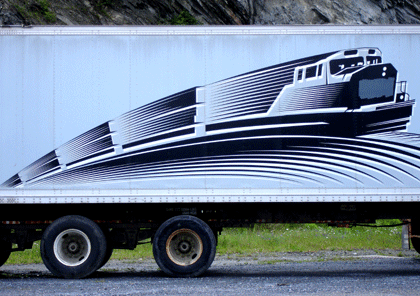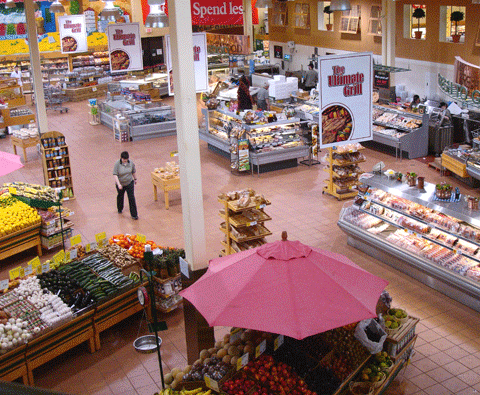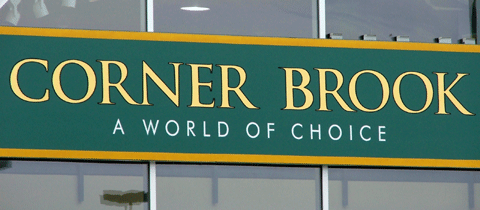
Labrador Caravan
July 10, 2007
Corner Brook
Corner Brook is Newfoundland’s second city. St. John’s, the capital, is first, with some 180,000 people in the urban area, 100,000 of them in the city itself. Corner Brook is a distant second – the city boasts a population of just over 20,000, down from 24,000 in the 1981 census. Major metropolitan areas are not Newfoundland’s strong suit.
Corner Brook is an industrial kind of place. Built at the upstream end of the Humber Arm, a long narrow inlet of the sea, its wide shore is dominated by a massive smoking pulp plant at the core of downtown. The town has spread along the shores and up the steep slopes surrounding the plant. From the exit off the Trans-Canada, a few miles away, it looks like a pretty, rather charming town. But as you head in you notice the sticky sweet smell of the pulp, and wonder how anyone can stand to live near the mill. It is the origin of the town, though. The area was a transitional waypoint for fisherman and lumberman well before it, but wasn’t settled permanently until the mill was built in the 1920s. And the social geography of the place is related.
|
The town was officially formed in the 1950s, with the consolidation of four distinct communities – one formed by the fishermen, one by the railroad interests, one by the blue-collar employees of the paper and pulp industry, and one by its founders and managers. Those groups apparently still dominate social relations here, according to Chris, whom I met while taking a photo on the Corner Brook Stream Trail. (He stopped to ask if I’d like him to take a picture of me, after which we spent three quarters of an hour chatting while the cup of coffee in his hand got colder and colder and I got hungrier and hungrier.) Chris grew up here, went to college in California, and – unlike most Newfoundlanders – was actually able to get work in his field in his home town. He’s a social worker, employed by the community health services, so he’s part of the relatively educated elite of the community. So he explained the community to me. Social life here is narrow, he said, and still segregated by community and by employment sector, even though the railroad is now a museum, its freight carried by trucks, and the fishery is dying. There’s the academic crowd – College of the North Atlantic and the Wilfred Grenfell campus of the St. John’s-based Memorial University of Newfoundland (MUN, to most folks) are both here. The MUN campus gives BAs and BSs, while CNA offers degrees in more applied subjects. I suppose if I lived in Corner Brook – which I won’t! – I’d try to find a network among the MUN and CNA faculty. |
 |

 |
Chris said a lot of the socializing is in “après-ski” events, which I’m guessing involve food and alcohol consumed in slick ski gear. Doesn’t quite sound like my scene. Chris is happy to have found a life in his home town – and lucky. He works with young people in the corrections system. His advice to them, he says, is “get an education, and get out.” The romantic notion of Newfoundland may focus on the richness and interdependence of the small towns, the strength of community among people who at one time had only each other to create their lives. But Chris’s perspective is that it’s a small, narrow world, and just doesn’t offer much of a future to the young people growing up there. He told me of his niece, who left to go to university in Ontario, and is now finishing her PhD in history and on the academic job market. She comes back to visit, but couldn’t imagine staying. The world is so much bigger than Newfoundland for her. She did her stint in that small world, and can’t imagine closing her life down enough to return here. I met another Chris in my travels, a transplanted Marylander who went to McGill and never left, now works on environmental education at Gros Morne National Park. She’s a seasonal employee of Parks Canada, gets away in the winters when the tourists have all left. One of the locals at the park told her he felt sorry for her, because once the tourists are gone she has no one in town to talk to. And she told me that’s true. I mentioned the woman I met last summer, the one whom I thought I’d be friends with if I were foolish enough to live in Woody Point (which I wouldn’t be!). She was organizing lectures in an effort to create some kind of intellectual life among the CFAs – come from aways – who want to be there because it’s beautiful, but don’t have any peers in the place. Oh yes, Chris said, Susan, I know her. Everyone knows each other here. | |
|
Two days later I ran into Chris in the Canadian Tire parking lot in Corner Brook. She and her daughter had driven the 120 kilometers from Gros Morne to buy groceries at the Dominion Supermarket, a Canadian chain that is almost as comprehensive and fancy as Wegman’s in the US. She was out of mustard, and could only get the yukky yellow kind in Woody Point, no good moutarde de Dijon there. No organic veggies, either, nor Fair Trade coffee, nor dried cranberries in bulk. In the past, she said, she used to go to Antigonish, Nova Scotia to get organic food. 325 kilometers on the road, six hours on the ferry, another 200 kilometers on the road. Just to get organic veggies. | ||
|
So the stores in Corner Brook are a godsend. Walmart is a godsend, for heaven’s sakes. At home I avoid Walmart like the plague, influenced by my desire to support local merchants, to keep local downtowns in business, to protest their treatment of their staff, to avoid being part of the stifling uniformity that comes with its global material culture. But in western Newfoundland, Walmart is the place to shop. They sell everything. They even have some choices in your purchase of everything. No one else in western Newfoundland sells any of it. A cheap CD player so I can listen to music now that the CD drive on my computer isn’t working. A replacement for my broken glass coffeepot. A plastic storage box for the top of the van to replace the one I cracked. Simple cheap earrings that I can wear all the time and won’t be allergic to. A battery for my watch. A set of Johnny Cash CDs that I’ll play on that new CD player one of these days. I even considered buying a camera at Walmart, when I thought I had lost both of mine. (I found them.) It’s no wonder that the guys from Labrador were headed to Walmart in Corner Brook |
 | |
|
when they got sidetracked by Matilda’s coolant troubles – it’s the only place to shop for hundreds of miles. That and Canadian Tire and Dominion. Yes, that shopping center on the edge of town, with its set of big box stores, has wiped out much of the commerce in downtown Corner Brook. I walked through one of the downtown shopping areas, and every single store was closed, the space available for rent. The other mall is about to become the home of the YMCA, moving out of its tatty building that smells like a locker room. The only store that has opened up is a dollar store. | ||
 |
But Walmart and Canadian Tire and Dominion Supermarket have also made Corner Brook into a commercial center for all of western Newfoundland and Labrador. Maybe on balance that will end up benefiting the town more than it harms it? I don’t know. But I’ve certainly given them my share of business. Continue to next entry. Return to the menu. |